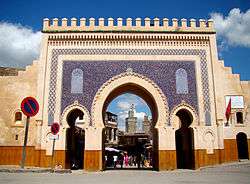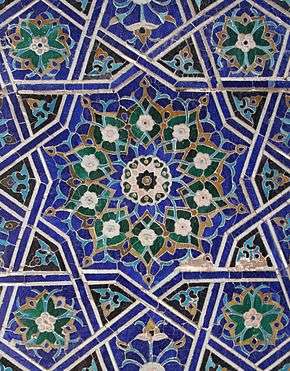Moroccan architecture
Moroccan architecture is a term describing Moroccan architectural houses. Morocco is in Northern-Africa bordering the Mediterranean and the Atlantic. The country's diverse geography and the land’s long history of being fought over by many countries are the major reasons why the country has developed a distinctive architectural styles. Its architecture reflects the country's rich cultural and historical heritage.
History

Morocco’s first independent state called the Berber kingdom of Mauretania was ruled by the Berbers clan. It was first documented during 110 BC. During the time of the Berbers, the country has been through several sieges by a number of invaders. Nevertheless, the Berbers ritual and beliefs still remained and became the country’s cultural heritage including its antique architecture. The Berbers are known for their use of earth or mud brick called pisé (French). Many of the massive pisé buildings had defensive functions as main trading posts and ports or guard walls against pirates and rivals. This ancient building method prevails in all sizes of buildings. Since pisé is a water- permeable material, the foundation is required to be rebuilt regularly; however, the repeating use of forms, materials and patterns resulted as Morocco’s distinctive architecture. Moreover, Moroccan traditional architecture also gained influences from neighboring countries and intruders. [1] [2] [3]
Influences
Islam

Morocco was not originally an Islamic state; however, its conversion of religion greatly influenced the overall architectural style of the country. The elegance of Islamic features is blended in and adapted into buildings and interior designs such as the use of tiling, fountains, geometric design and floral motifs. Which could be seen in mosques, palaces, plazas as well as homes.[4]
- Tiling – Zellige tiling, often wrongly labelled "mosaic", is used to decorate the surfaces of buildings and objects. The tiling concept was brought to the country by the Persians.
- Fountains – Before the conversion, water was already an important part of Moroccan culture; however, Islam made water much more important functionally because Muslim needs to clean themselves before praying. Thus, fountains, also representing paradise, could be found everywhere in order to serve everyone.
- Mosques – Due to the change of religion, numbers of mosques were built in Morocco. Still their mosques differ from the others because they do not face Mecca like the other countries.
- Geometric Design and Floral Motifs – Based on Islamic beliefs, avoiding the use of human or animal images is preferable resulting in the spread of floral motifs (arabesques) and geometric patterns. The motifs are apply to ordinary materials or surfaces.
Spanish
There is similarity between southern Spanish (Al-Andaluz) and Moroccan cultures in terms of climate and elaborate design details. The spread of Spanish art started with the Spanish immigration during the 1500s, the new conferee influenced Moroccan tiling, use of arches and the Great Andalusian-style garden.
- Tiling – Overlapping roof tiling became popular after the influence of Spain; the tiles are mostly hand glazed.
- Arches – Arches are common feature in Morocco, which can be divided into two types. The first arch is the horseshoe which is clover shaped. The second is cusped like a rounded keyhole. These are called Moorish arches.
- Andalusian gardens – The landscape of the Alhambra garden in Grenada is the greatest inspiration for Moroccan public and private gardens.
French

France occupied Morocco in 1912. Later, as a result of the unorganized growth of real estate in the late 1800s to early 1900s, the French protector declared regulations for building standards which directly affected the architecture at that time, as follows:
- Buildings could not be higher than four stories.
- Land use regulation required twenty percent of a planned area to be courtyards or gardens.
- Balconies must not overlook neighboring residences.
- Roofs of all buildings should be flat.
The building regulations maintained the country's preexisting architectural features and balanced the rapid urbanization.
Types of house
Riad
The Riad or Dar is the Moroccan traditional house, which normally has two or more storeys around a courtyard.[5]
Villa
Villas are larger stand-alone housing in the urbanized area which do not need to follow traditional architectural style.
Architectural Features

Arches are used in almost every aspect of Moroccan housing whether it is doors, entrances, windows or niches.
Domes are often integrated with altars or commemoratory monuments as well as modern villas.
The interior doors of villas are usually oversized and decorative. In contrast, very small doors are used in dars. Doors are often adorned with delicate metal work, carving or color.
In contrast with doors, windows in Moroccan architecture are often unremarkable. They are normally arched glass panes with fewer adornments compared to doors.
Mashrabiya is an Islamic dowel work, made by carving large wood partitions in elaborate geometric patterns. Its purpose is to conceal the women from the visitor’s prying eyes according to Islamic tradition.
The fountain is a conspicuous feature in every house, often made of marble or cement. It is built in the heart of the courtyard, living room or guest room.
Design Elements

Woodwork
Woodwork can be found in both urbanized and more traditional areas of Morocco. The woodwork serves as the main finishing. This intricate woodwork can be found on various surfaces of buildings especially the interiors, such as wall, ceiling window, gallery and balcony. The wood itself does not need to be finished or painted after the long process of delicate carving.[6]
Plaster
Tadelakt, qadad, and non-waterproof plasters are used. They may be polished smooth or elaborately carved into yeseria.
Metalwork
Copper, bronze, iron and brass are materials commonly used for studs, door knobs, window frames and door frames as well as room partitions.
Ceramics
A wide variety of ceramics is produced in Morocco. The painted and glazed ceramics are used for architectural work and tableware. Some are commonly used as roof tiling and decorative zellige tilework. The process of tiling, arranging and cutting them requires expertise in order to deliver a detailed piece of work.[8]
Color Palettes
Moroccan is known for their vivid and colorful design. However the diversity of colors that are included in the design all holds different connotations.[9]
| Color | Color Range | Symbolism | Usage |
|---|---|---|---|
| Blue | Greenish Turquoise, Fresh Fez Blue, Electric Majorelle Blue, Dark and Light Indigos | Sky, Heaven, Water, Planet Mercury. Muslims believed the color could protect them from evil’s eyes, also believe that it can enhance one medical and cosmetic condition. | Tiling, Floor, Textiles, Door and window frames, Garden furniture |
| White | White, Ivory, Beige | Cleanness, Good luck, Beauty, Femininity. Based on Muslim belief these colors connote moral qualities. | Commonly found in textiles using different materials. As a complement to other Moroccan patterns that use darker colors. |
| Red | Salmon, Rosy Pink, Fuchsia, Apple Red, Brick Red, Carmine, Violet, Bordeaux | Female, Sexuality, Fertility, Childbirth which relates to happy marriage. Some said it also represent the planet Mars. | Walls, Roof tiles, Carpets, Pottery |
| Black | Black, Soft Black, Smoke, Brown | Though the scheme is popularly used, however it holds a negative connotation. Believe that these colors are likely to bring bad luck and grief. | Mosaic, Carpets, Textiles. However it is use frequently in various items since it is a base color in their design. |
| Green | Bottle Green, Blue Green, Grass Green | The color relates with the Muslim interpretation of heaven presumably because it is in between the reddish hell and the blue heaven based on their belief. | Pottery, Tiling, Ceiling Painting, Furniture |
| Yellow | Gold, Lemon Yellow, Dark Yellow, Orange Yellow, Orange | Gold, Wealth, Sun. Believed that these colors would protect them from evil. | Textiles and embroidery, Tiling, Painted decoration on furniture, Leather products, Carpets |
See also
References
- ↑ Ypma, H. (2010). Morocco modern. New York, N.Y.: Thames & Hudson.
- ↑ Sharing sense: Or, how ethics might be the subject matter of architectural aesthetics | Leatherbarrow | ArchitecturePhilosophy. (n.d.). Retrieved October 9, 2015.
- ↑ Bing, A. (2010, August 20). Moroccan architecture - Lonely Planet. Retrieved October 9, 2015.
- ↑ Montague, M. (2012). Marrakesh by design: Decorating with all the colors, patterns, and magic of Morocco. New York: Artisan.
- ↑ Wilbaux, Quentin; Lebrun, Michel; McElhearn, Kirk (2008). Marrakesh: The Secret of Courtyard Houses. www.acr-edition.com. ISBN 978-2-86770-130-6.
- ↑ Jereb, J. (1996). Arts & crafts of Morocco. San Francisco: Chronicle Books.
- ↑ http://www.laksiba.com/about-riad-laksiba/4553124575
- ↑ Aboufadil, Y., Thalal, A., & Raghni, M. (2013). "Symmetry groups of Moroccan geometric woodwork patterns". Journal of Applied Crystallography, 46, 1–8.
- ↑ Montague, M. (2012). Marrakesh by design: Decorating with all the colors, patterns, and magic of Morocco. New York: Artisan.


.jpg)

